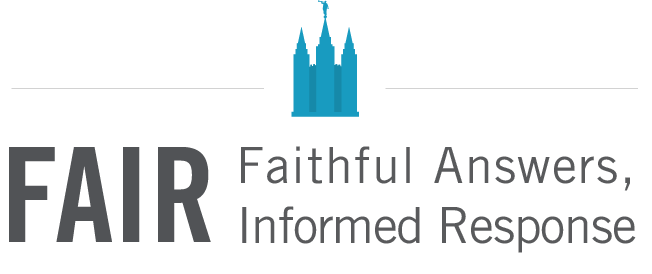
FAIR is a non-profit organization dedicated to providing well-documented answers to criticisms of the doctrine, practice, and history of The Church of Jesus Christ of Latter-day Saints.
m (→Question) |
m (→Answer) |
||
| Line 14: | Line 14: | ||
What this has to do with the validity of Weston's "17 Points" is not entirely clear, but it seems that the critic is attempting to discredit Weston's list (and, by implication, the Church) by discrediting Weston himself. This would be a form of the [[Logical_fallacies#ad_hominem_abusive|''ad hominem'']] fallacy. | What this has to do with the validity of Weston's "17 Points" is not entirely clear, but it seems that the critic is attempting to discredit Weston's list (and, by implication, the Church) by discrediting Weston himself. This would be a form of the [[Logical_fallacies#ad_hominem_abusive|''ad hominem'']] fallacy. | ||
The assumptions underlying the "17 points" are highly dependent upon a worldview widely assumed by Utah Mormons, but which rarely reflects the situation of those who are not members of the LDS Church: the idea that there is "one true church" and that people will accept the LDS faith once they are logically convinced that it "matches" the New Testament Church in salient ways. In reality, these concepts are totally foreign to the worldview of most non-Mormons, and depend a great deal on the assumptions which one brings to such an analysis. | |||
"17 Points" is thus a resource that may be interesting to Latter-day Saints in examining the scriptural basis for certain features of the modern Church, but is one that has very little value or relevance to the missionary effort. Most non-members are likely more effectively approached about the gospel in entirely different ways, and following the Church's emphasis on such things as the mission of Joseph Smith and the Book of Mormon are more likely to be effective missionary tools. | |||
==Conclusion== | ==Conclusion== | ||
This page is based on an answer to a question submitted to the FAIR web site, or a frequently asked question.
Someone wrote the FAIR Ask the Apologist service saying:
The person responsible for the "17 Points of the True Church" is a man named Floyd Weston.
An ex-Mormon critic of the Church has claimed that Weston fabricated the details of how the "17 Points" were created. For example, Weston claims to have developed the list when he was a student at Cal Tech, and that during this time Albert Einstein visited the school. The critic has charged that Weston was actually at Cal Tech several years too late to see Einstein's visit. All of this is based on an email to the critic from an anonymous person who claims to know someone who knew Weston. So, the source is anonymous and almost impossible to verify. Anyone with further verifiable information is invited to contact FAIR.
What this has to do with the validity of Weston's "17 Points" is not entirely clear, but it seems that the critic is attempting to discredit Weston's list (and, by implication, the Church) by discrediting Weston himself. This would be a form of the ad hominem fallacy.
The assumptions underlying the "17 points" are highly dependent upon a worldview widely assumed by Utah Mormons, but which rarely reflects the situation of those who are not members of the LDS Church: the idea that there is "one true church" and that people will accept the LDS faith once they are logically convinced that it "matches" the New Testament Church in salient ways. In reality, these concepts are totally foreign to the worldview of most non-Mormons, and depend a great deal on the assumptions which one brings to such an analysis.
"17 Points" is thus a resource that may be interesting to Latter-day Saints in examining the scriptural basis for certain features of the modern Church, but is one that has very little value or relevance to the missionary effort. Most non-members are likely more effectively approached about the gospel in entirely different ways, and following the Church's emphasis on such things as the mission of Joseph Smith and the Book of Mormon are more likely to be effective missionary tools.
It makes little difference for the Church if Weston made up his story. (Though lying to defend the Church is not excusable.) The truth or falsity of Weston's personal history has no bearing whatsoever on the truth of the restored gospel.
Additionally, the "17 Points" may be used by certain individual members of the Church, but they have not been used in any official Church publications or adopted by the Church in any other way. The claims of the restored gospel stand independent of Weston's list.

FAIR is a non-profit organization dedicated to providing well-documented answers to criticisms of the doctrine, practice, and history of The Church of Jesus Christ of Latter-day Saints.
We are a volunteer organization. We invite you to give back.
Donate Now